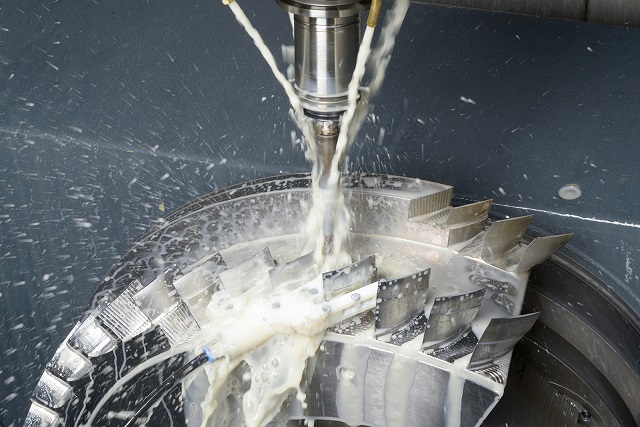 The three-part clamping system holds the blisk blades (just below the middle of the picture in white). Cooling lubricant is being injected from above. (Credit: Fraunhofer IPT)
The three-part clamping system holds the blisk blades (just below the middle of the picture in white). Cooling lubricant is being injected from above. (Credit: Fraunhofer IPT)
The researchers at the Fraunhofer Institute for Production Technology IPT in Aachen have developed a new clamping system that holds promise in eliminating vibration of blades during processing. This novel clamping system is capable of improving vibration absorption of blades by over 400 times and cuts the manufacturing costs by 5000 Euros.
With an increase in air traffic and hence passenger traffic every fifteen years, aircraft turbine manufacturers need to match their production capacity to this growing demand. This is a challenging task. Turbine blades are usually mounted on compressor disks. These disks are now manufactured using a single piece of material to make them light in weight, instead of the old method of constructing blade by blade. Compressor disks produced in this manner are known as “blade-integrated disks” or “blisks” and are designed to compress air in the turbine.
As turbine blades are naturally long and thin, manufacturing all of them together may cause severe problems. These blades tend to vibrate like a tuning fork at the time of production, which hinders further processing. For this reason, manufacturers completely avoid milling of each blade and follow a step by step procedure where they process the outer edge of the blade to its finished state first. However, there are some problems with this manufacturing process as well. The geometry of the turbine blades may get slightly twisted due to the tension on the turbine blades.
“With the clamping system, absorption in titanium blisks is 12.5 percent. Without it, absorption falls to just 0.027 percent,” says Roman Kalocsay, an engineer at IPT. The manufacturers can roughly produce the blades first with the clamping system followed by the precise finishing work as they do not vibrate any more.
Elimination of vibration using the clamping system reduces the manufacturing costs to 5000 Euros per blisk. The cost of the components may vary between 30,000 and 80,000 Euros as the vibrating blades tend to stress the cutting edge of the tools thereby forming fissures. The size of the fissures may quickly increase with mechanical and thermal stress. Tools need to be replaced only after cutting 4m of material. However, it is evident from previous experiments that the lifespan of the tools are increased two to three times than before.
So How does the clamping system work?
Spring-loaded clamps automatically grasp the blade with equal amounts of tension on both sides. As soon as the elements are in position, they are hydraulically clamped in place and hold the workpiece as if it had grown there.
Kalocsay
The Fraunhofer Innovation Cluster Adaptive Production for Resource Efficiency in Energy Generation and Mobility AdaM created the prototype of the clamping system.
At the time of repair, it is impossible to manufacture the blades piece by piece out of the material since all the blades are already in place. However, if the edges of the blades were found to be "frayed", for instance, the manufacturer uses a laser metal deposition to reapply the material and then manufactures it to the required shape. Workers try to catch the blade in a suitable position using clamps or rubber, yet it is quite challenging to perfectly align them. Therefore, the workpieces need to be re-measured later to know the extent of their displacement to the left or right. The clamping system can be of great use here as well. “It doesn’t change the blisk’s geometry by even a micrometer. The blade is fixed in place in just a few seconds and can be worked on immediately,” says Kalocsay. The process is quite different that with a new blisk. The clamping elements are arranged in a circular fashion, and all the blades are held simultaneously.
References